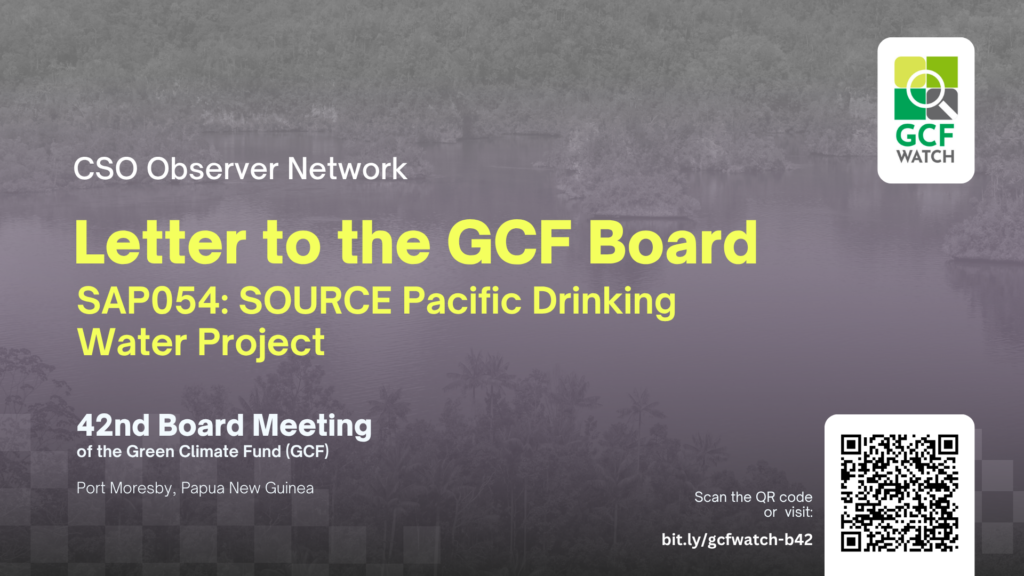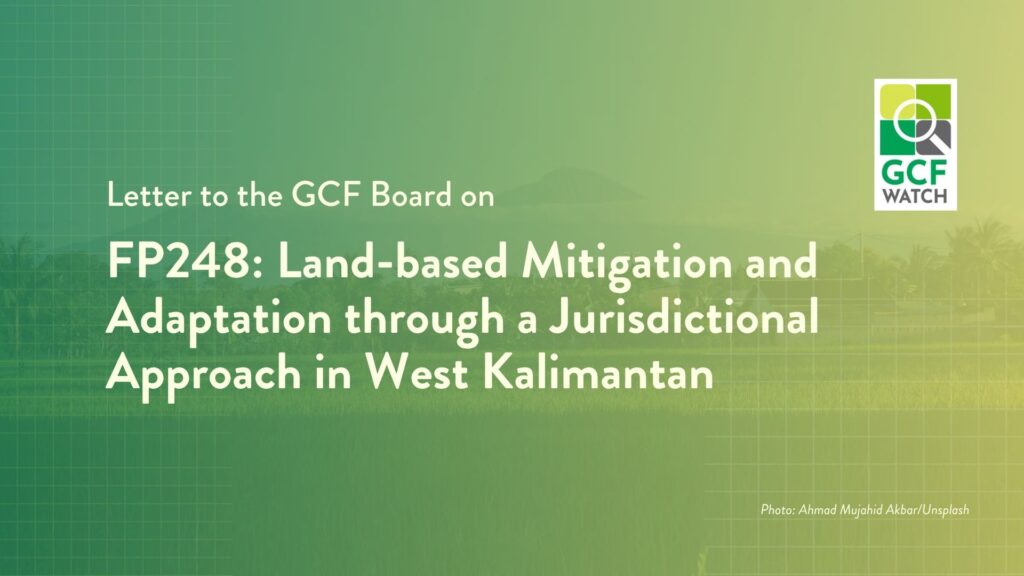Letter to the GCF Board: Concerns on the Late Disclosure of Funding Proposals for B.43
Dear Board members, alternates, and advisors:
We have grave concerns that the Green Climate Fund (GCF) and the Board are setting a dangerous precedent by considering funding proposals at B.43 that were not published 21 days prior to Board action, in line with the Information Disclosure Policy and the Rules of Procedure, including the precedent of considering a funding proposal for a large programme with many intended sub-projects whose environmental and social impact assessment remains incomplete. Policies, including policy timelines, are critical for ensuring participation of potentially impacted people, and we call on Board members to 1) emphasize their concern about this breach of policy, 2) stress that no repeat of this policy violation should occur, and, 3) given its considerable risks and incompleteness, reject any consideration of FP288 at this meeting.
FP264, FP288, and SAP065 were disclosed on October 14, 2025 – only 13 days before B.43 is scheduled to begin – while the other funding proposals for this Board meeting were disclosed on October 3, 2025.
Since the adoption of the Information Disclosure Policy in 2016, the vast majority of the funding proposals have been disclosed 21 days ahead of Board action; the last time we saw timelines this short was at B.14 in October 2016 and also with the very first SAP at B.19. The Information Disclosure Policy as well as the Rules of Procedure reinforce these publication standards, with the latter referring to disclosure outside of that timeline as merited by exceptional circumstances as approved by the Co-Chairs. At a time when the GCF is often referred to as a mature institution, promoting efficiency, violating its own policies in new and harmful ways is not a sign of a well-managed fund.
It is particularly important to strictly adhere to disclosure timelines for funding proposals to allow sufficient time for outreach to community partners, a key function of the GCF observer network of civil society, Indigenous Peoples, and local communities. These publication timelines are not simply a function of disclosure to serve Board members or procedural formalities; they provide a basic and fundamental accountability measure for the communities who are supposed to be served by the ultimate implementation of these funding proposals.
Whereas policy documents disclosed late often (but not always) have had some level of public consultation, these FPs have not had public scrutiny until publication – and efforts to ensure the names and countries of the FPs are disclosed earlier to facilitate greater community outreach have been denied by the GCF. Communities are thus reliant on accredited entities’ stakeholder engagement, which is sometimes found to be lacking—consider the 2024 case of FP248 where 21 days notice barely provided enough time for Indigenous Peoples and community leaders to formally register that their engagement had been mischaracterized. And while Category A, B, I-1, and I-2 proposals do have ESS disclosures prior to the 21-day window, an ESS disclosure is not a funding proposal description, where entities and actors, theories of change, an understanding of financial structure, more details on the actual project or programme, etc. are shared.
In this case, SAP065 is being moved ahead despite the fact that the large majority, 85%, of the promised co-financing has not been secured, which as the Independent Technical Advisory Panel (ITAP) notes could have important implications for the project’s “overall viability from delayed implementation, reduced coverage, and non or partial achievement of climate adaptation outcomes.”
FP264’s late disclosure seems nonsensical as it is identical to the B.42 version. We have considerable concerns about this proposal and think it should be rejected by the Board, as stressed in our letter in advance of B.41. We would also request an explanation as to why a proposal that is identical to that posted before B.42 was not circulated according to the GCF minimum deadline, to better understand what issues have already been raised. That said, we do not object to it being opened on the floor for discussion, as the B.42 version should have been opened for discussion as all proposals disclosed publicly 21 days ahead of time merit Board discussion.
FP288 poses the greatest danger to the GCF’s reputation and the integrity of its processes—one of the largest GCF proposals ever considered, with the highest risk category, Category A, is one that deserves the full amount of public scrutiny. The requested US$295 million would make this the third largest GCF funding approval ever and the largest for a single project (as opposed to a programmatic approach). It includes a US$75 million grant component, which would be the largest grant from the GCF to a single private sector project as only one private sector programme received a larger grant.
Additionally, the ITAP has flagged that such a proposal is being pushed through despite the fact that it has NOT fulfilled its ESS requirements. As the ITAP report makes clear, the Board is being asked to approve a proposal based on assumptions, not evidence:
The environmental and social impact assessment (ESIA) update remains incomplete. As of the latest submission, Board members still cannot have assurance that coral reefs and tourism assets in the Gulf of Aqaba will be protected. The AE noted in its response to iTAP questions: “The ESIA addendum is under preparation and will be submitted prior to financial close.” While this may satisfy regulatory timelines, the absence of this assessment at Board approval means that members are being asked to authorize one of the largest GCF private-sector grants without seeing evidence that marine ecosystems will be safeguarded. Given that IFC is a highly rigorous AE in defining and upholding the do-no-harm Equator Principles, the iTAP feels confident it will be done to the highest standard. However, the Secretariat is setting a precedent here: iTAP cannot assess the quality of minimum safeguards before Board approval. If in the future other AEs—which do not have the same capabilities and track record as IFC—are unable to provide a satisfactory assessment of environmental and social risk upfront, iTAP would have to reach a different conclusion in the absence of a finalized ESIA.
As the ITAP further makes clear, there are also significant risks that the project could increase greenhouse gas emissions while delivering very poor value for the GCF’s investment because of questionable climate impact. While we do not share the ITAP’s confidence in the IFC’s standards and its ability to uphold them, it is critical to note that the ITAP report reveals a second precedent the Board would be setting with the consideration of this proposal. As a private sector programme, there is also no public disclosure of the Secretariat assessment or any of the annexes, which could indicate due diligence in terms of stakeholder engagement procedures and other documentation, such as an Indigenous Peoples Plan, in the absence of a completed ESIA.
Access to funding is one of the basic tenets of the GCF’s operations and, indeed, access has been granted for many years following the same process with the same disclosure timelines. Any claim that ten years into the GCF’s operations such a breach of practice and policy is necessary to ensure access to funding is simply not borne out by the GCF’s 18 billion dollar history. And the notion that such a breach would be needed for one of the largest international accredited entities to secure financing is comical; these circumstances are not “exceptional”. Indeed, such a violation only creates risks—for communities’ trust in the GCF, for the GCF’s continued operations in alignment and integrity with their own policies, for the GCF’s reputation, and for the ecosystems and people who may be harmed by these projects and who are supposed to benefit particularly from FP288.
The GCF observer network fully supports access to funding, but not at the expense of policies and processes that have been carefully crafted, considered, and enacted through years of Board member, Secretariat, and observer deliberation and input. The GCF processes for funding proposal design, consideration, and implementation exist for a reason, and yet it does not escape us that those reasons seem to be dismissed when the potential of funding for the private sector arises, as each of these three late-disclosed projects is a private sector project. Before the Board sets not one, but two poor precedents in contravention to the GCF’s history, practices, and policies, we ask that you consider the long-term cost to this short-term, so-called gain of pushing unexamined funding out the door.
Sincerely,
The GCF observer network of civil society, Indigenous Peoples, and local communities








